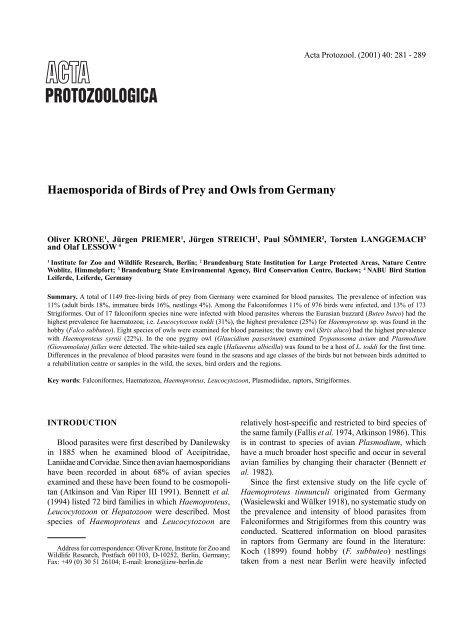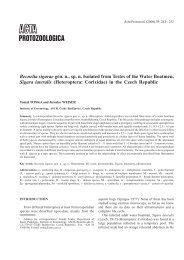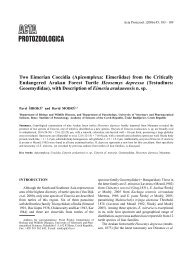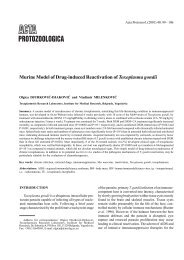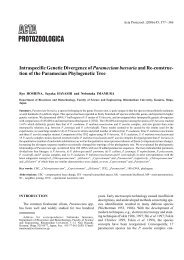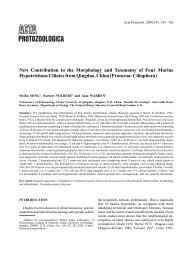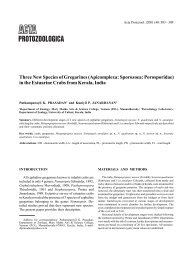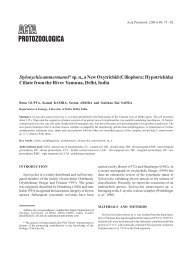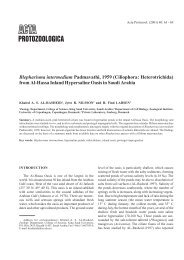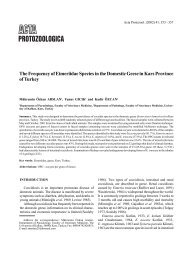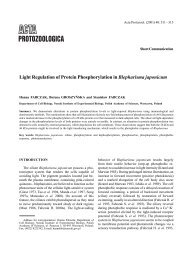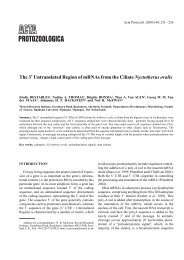Haemosporida of Birds of Prey and Owls from Germany
Haemosporida of Birds of Prey and Owls from Germany
Haemosporida of Birds of Prey and Owls from Germany
You also want an ePaper? Increase the reach of your titles
YUMPU automatically turns print PDFs into web optimized ePapers that Google loves.
<strong>Haemosporida</strong> <strong>of</strong> <strong>Birds</strong> <strong>of</strong> <strong>Prey</strong> <strong>and</strong> <strong>Owls</strong> <strong>from</strong> <strong>Germany</strong><br />
Acta Protozool. (2001) 40: 281 - 289<br />
Oliver KRONE 1 , Jürgen PRIEMER 1 , Jürgen STREICH 1 , Paul SÖMMER 2 , Torsten LANGGEMACH 3<br />
<strong>and</strong> Olaf LESSOW 4<br />
1 Institute for Zoo <strong>and</strong> Wildlife Research, Berlin; 2 Br<strong>and</strong>enburg State Institution for Large Protected Areas, Nature Centre<br />
Woblitz, Himmelpfort; 3 Br<strong>and</strong>enburg State Environmental Agency, Bird Conservation Centre, Buckow; 4 NABU Bird Station<br />
Leiferde, Leiferde, <strong>Germany</strong><br />
Summary. A total <strong>of</strong> 1149 free-living birds <strong>of</strong> prey <strong>from</strong> <strong>Germany</strong> were examined for blood parasites. The prevalence <strong>of</strong> infection was<br />
11% (adult birds 18%, immature birds 16%, nestlings 4%). Among the Falconiformes 11% <strong>of</strong> 976 birds were infected, <strong>and</strong> 13% <strong>of</strong> 173<br />
Strigiformes. Out <strong>of</strong> 17 falconiform species nine were infected with blood parasites whereas the Eurasian buzzard (Buteo buteo) had the<br />
highest prevalence for haematozoa; i.e. Leucocytozoon toddi (31%), the highest prevalence (25%) for Haemoproteus sp. was found in the<br />
hobby (Falco subbuteo). Eight species <strong>of</strong> owls were examined for blood parasites; the tawny owl (Strix aluco) had the highest prevalence<br />
with Haemoproteus syrnii (22%). In the one pygmy owl (Glaucidium passerinum) examined Trypanosoma avium <strong>and</strong> Plasmodium<br />
(Giovannolaia) fallax were detected. The white-tailed sea eagle (Haliaeetus albicilla) was found to be a host <strong>of</strong> L. toddi for the first time.<br />
Differences in the prevalence <strong>of</strong> blood parasites were found in the seasons <strong>and</strong> age classes <strong>of</strong> the birds but not between birds admitted to<br />
a rehabilitation centre or samples in the wild, the sexes, bird orders <strong>and</strong> the regions.<br />
Key words: Falconiformes, Haematozoa, Haemoproteus, Leucocytozoon, Plasmodiidae, raptors, Strigiformes.<br />
INTRODUCTION<br />
Blood parasites were first described by Danilewsky<br />
in 1885 when he examined blood <strong>of</strong> Accipitridae,<br />
Laniidae <strong>and</strong> Corvidae. Since then avian haemosporidians<br />
have been recorded in about 68% <strong>of</strong> avian species<br />
examined <strong>and</strong> these have been found to be cosmopolitan<br />
(Atkinson <strong>and</strong> Van Riper III 1991). Bennett et al.<br />
(1994) listed 72 bird families in which Haemoproteus,<br />
Leucocytozoon or Hepatozoon were described. Most<br />
species <strong>of</strong> Haemoproteus <strong>and</strong> Leucocytozoon are<br />
Address for correspondence: Oliver Krone, Institute for Zoo <strong>and</strong><br />
Wildlife Research, Postfach 601103, D-10252, Berlin, <strong>Germany</strong>;<br />
Fax: +49 (0) 30 51 26104; E-mail: krone@izw-berlin.de<br />
relatively host-specific <strong>and</strong> restricted to bird species <strong>of</strong><br />
the same family (Fallis et al. 1974, Atkinson 1986). This<br />
is in contrast to species <strong>of</strong> avian Plasmodium, which<br />
have a much broader host specific <strong>and</strong> occur in several<br />
avian families by changing their character (Bennett et<br />
al. 1982).<br />
Since the first extensive study on the life cycle <strong>of</strong><br />
Haemoproteus tinnunculi originated <strong>from</strong> <strong>Germany</strong><br />
(Wasielewski <strong>and</strong> Wülker 1918), no systematic study on<br />
the prevalence <strong>and</strong> intensity <strong>of</strong> blood parasites <strong>from</strong><br />
Falconiformes <strong>and</strong> Strigiformes <strong>from</strong> this country was<br />
conducted. Scattered information on blood parasites<br />
in raptors <strong>from</strong> <strong>Germany</strong> are found in the literature:<br />
Koch (1899) found hobby (F. subbuteo) nestlings<br />
taken <strong>from</strong> a nest near Berlin were heavily infected
282 O. Krone et al.<br />
with Haemoproteus sp. Mayer (1911) described<br />
Haemoproteus sp. in 2 <strong>of</strong> 3 tawny owls (Strix aluco)<br />
<strong>from</strong> Lübeck. Information on Leucocytozoon spp. is not<br />
reliable due to possible confusion with Trypanosoma<br />
spp. in the early studies <strong>of</strong> haematozoan research<br />
(Schaudin 1904; Mayer 1910, 1911; Moldovan 1913).<br />
This study considers the prevalence <strong>and</strong> intensity <strong>of</strong><br />
the genera Haemoproteus, Leucocytozoon <strong>and</strong> Plasmodium,<br />
in falconiform <strong>and</strong> strigiform birds <strong>from</strong> <strong>Germany</strong>.<br />
MATERIALS AND METHODS<br />
The birds examined in this study <strong>from</strong> 1996-2000 were wild birds<br />
admitted to rehabilitation centres sampled during the first two days<br />
after admission or birds sampled during ringing. <strong>Birds</strong> originated <strong>from</strong><br />
mainly three different locations in <strong>Germany</strong>: Baden-Württemberg<br />
(BW) (47°50’ to 49°25’ N, 8°50’ to 9°75’ E), Lower Saxony (LS)<br />
(52°00’ to 53°00’ N, 9°50’ to 11°00’ E) <strong>and</strong> Berlin-Br<strong>and</strong>enburg<br />
(BB) (52°00’ to 53°25’ N, 11°50’ to 14°50’ E). Twenty-five different<br />
species <strong>of</strong> raptors in 5 families were subject to this study (Table 2).<br />
Identification <strong>of</strong> the bird species <strong>and</strong> the age categories was based on<br />
the descriptions by Baker (1993), Forsman (1999) <strong>and</strong> Glutz von<br />
Blotzheim (1971). The ageing <strong>of</strong> the pulli was performed by using the<br />
descriptions <strong>of</strong> Heinroth <strong>and</strong> Heinroth (1927) <strong>and</strong> the tables <strong>of</strong><br />
growth for the falconiformes (Bijlsma 1997). A total <strong>of</strong> 976 blood<br />
smears <strong>from</strong> falconiform <strong>and</strong> 173 <strong>from</strong> strigiform birds were examined<br />
for the presence <strong>of</strong> blood parasites.<br />
Samples were taken <strong>from</strong> the brachial vein. Blood films were air<br />
dried, fixed in absolute methanol <strong>and</strong> stained with Giemsa´s solution<br />
for 40 minutes. The scanning time was 10 min for every blood smear<br />
examined. They were scanned at x25 for 0.5 min, x100 for 1,5 min,<br />
x200 for 2 min, <strong>and</strong> x400 for 6 min. The oil immersion (x1000) was<br />
only used when the blood smear contained parasites. Measurements<br />
were performed with a Zeiss Axioplan microscope attached via a<br />
video camera to a PC with AnalysisPro 2.1 as s<strong>of</strong>tware. Intensities <strong>of</strong><br />
parasites were calculated by counting them in fields <strong>of</strong> 300-400<br />
erythrocytes in 10 fields.<br />
Species identification was based on the descriptions by Peirce et<br />
al. (1990) for Haemoproteus brachiatus, H. tinnunculi, H. elani <strong>and</strong><br />
H. nisis, but for H. buteonis by Valkiûnas (1997), <strong>and</strong> by Bishop <strong>and</strong><br />
Bennett (1989) <strong>of</strong> strigiform birds; for Leucocytozoon <strong>of</strong> Falconiformes<br />
by Greiner <strong>and</strong> Kocan (1977) <strong>and</strong> <strong>of</strong> Strigiformes by Bennett et al.<br />
(1993), for Plasmodium by Garnham (1966). Trypanosoma avium<br />
<strong>from</strong> the pygmy owl (Glaucidium passerinum) was described previously<br />
by Krone (1996).<br />
The age (three classes: nestling, immature bird, adult bird), sex,<br />
origin (seven regions), order (Falconiformes or Strigiformes), bird<br />
species (25 species), <strong>and</strong> a possible injury or disease (birds admitted<br />
to rehabilitation centres) were regarded as variables potentially influencing<br />
its parasite burden (two categories: infected/not infected).<br />
Logistic regression (Hosmer <strong>and</strong> Lemeshow 1989) was used in order<br />
to analyse the effect <strong>of</strong> multiple variables on the parasite load.<br />
Categorical variables were compared by means <strong>of</strong> chi-square test or<br />
Fisher’s exact test. Adjusted st<strong>and</strong>ardised residuals were used to<br />
identify the categories responsible for a significant chi-square test<br />
(Everitt 1977). St<strong>and</strong>ardised residuals beyond ± 1.96 indicate a significant<br />
deviation <strong>from</strong> the expected values. The McNemar test<br />
(Bortz et al. 1990) served to compare prevalences for samples with<br />
related parasite information. A potential trend for the prevalences <strong>of</strong><br />
the age classes was tested using Pfanzagl’s trend test (Bortz et al.<br />
1990). The significance level was generally set to α = 0.05. All<br />
statistical calculations were performed using the SPSS 9.0 s<strong>of</strong>tware.<br />
RESULTS<br />
A total <strong>of</strong> 11% (n=1149; 95% CI: 10, 13) <strong>of</strong> blood<br />
smears <strong>from</strong> birds <strong>of</strong> prey were positive for haematozoa.<br />
A similar prevalence was found in Falconiformes<br />
(n=976, 11%; 9, 13) <strong>and</strong> Strigiformes (n=173, 13%;<br />
8, 19). The nestlings (pulli) had the lowest, whereas adult<br />
birds had the highest prevalences.<br />
Of 17 hawk species examined, 9 were found to be<br />
infected with haemoparasites (Table 1). In comparison<br />
only 3 <strong>of</strong> 8 owl species examined were infected<br />
(Table 2).<br />
No haematozoa were found in the osprey (P<strong>and</strong>ion<br />
haliaetus, pulli n=40, immature n=5, adult n=28), honey<br />
buzzard (Pernis apivorus, n=13), black kite (Milvus<br />
migrans, n=11), marsh harrier (Circus aeruginosus,<br />
pulli n=16, immature n=6, adult n=4), hen harrier (Circus<br />
cyaneus, n=1), montagu´s harrier (Circus pygargus,<br />
pulli n=31), merlin (Falco columbarius, n=1) <strong>and</strong> peregrine<br />
falcon (Falco peregrinus, pulli n=36, immature<br />
n=1, adult n=7).<br />
No blood parasites were found in the barn owl (Tyto<br />
alba, pulli n=25, immature n=6, adult n=31), Tengmalm´s<br />
owl (Aegolius funereus, n=1), short-eared owl (Asio<br />
flammeus, n=1), little owl (Athene noctua, n=1) <strong>and</strong><br />
eagle owl (Bubo bubo, n=8).<br />
The hawks were mainly infected with Leucocytozoon<br />
toddi (9.5%, n=976) <strong>and</strong> only a few with Haemoproteus<br />
spp. (1.9%, n=976) while an equal number <strong>of</strong> owls<br />
were infected with L. ziemanni (10.4%, n=173) <strong>and</strong><br />
H. syrnii (9.2%, n=173). Plasmodium fallax <strong>and</strong><br />
Trypanosoma avium were only detected in the single<br />
pygmy owl examined. Measurements <strong>of</strong> the blood parasites<br />
are presented <strong>from</strong> infected birds in which large<br />
numbers <strong>of</strong> haemoparasites were found (Table 3).<br />
A logistic regression was performed using the age,<br />
order, origin, season, <strong>and</strong> the admission to a rehabilitation<br />
centre as independent <strong>and</strong> the infection state as dependent<br />
variable. The sex was known only for 547 out <strong>of</strong><br />
1149 birds. Therefore, the influence <strong>of</strong> sex was separately<br />
tested, in order to use the full data set in the
multiple analysis. No significant differences in the infection<br />
state <strong>of</strong> the sexes occurred (Fisher’s exact test,<br />
P=0.358, n=547). The logistic regression revealed significant<br />
differences between the age classes (P
284 O. Krone et al.<br />
Table 2. Prevalences <strong>and</strong> intensities <strong>of</strong> blood parasites in Strigiformes; for abbreviations see Table 1<br />
Species n Leucocytozoon Haemoproteus Leuco. + Haemo. other<br />
Asio otus 25 1<br />
pull. 4 1<br />
intensity 0.40%<br />
immat. 1<br />
ad. 20<br />
Glaucidium passerinum 1 T. avium<br />
ad. 1 P. fallax<br />
intensity 0.15%<br />
Strix aluco 73 16 (21.9%) 17 (23.3%) 12 (16.4%)<br />
pull. 33 1<br />
intensity 0.05%<br />
immat. 11 2 2 1<br />
intensity m (min-max) SD 0.2 (0.05-0.35) 0.21 12.2 (0.15-24.25) 17<br />
ad. 29 13 15 11<br />
intensity m (min-max) SD 0.35 (0.05-0.8) 0.28 9.22 (0.15-34.4) 9.5<br />
Fig. 1. Prevalence <strong>of</strong> blood parasites in adult Eurasian buzzards over the year (numbers above the bars are birds examined)<br />
residual SR=-4.4) <strong>and</strong> above average in spring<br />
(SR=2.7) <strong>and</strong> autumn (SR=3.5). Differences between<br />
the age classes were also confirmed (chi-square test,<br />
p
<strong>Birds</strong> <strong>Haemosporida</strong> 285<br />
Table 3. Measurements (mean in µm, st<strong>and</strong>ard deviation in parentheses) <strong>of</strong> Haemoproteus spp. found in Falconiformes <strong>and</strong> Strigiformes;<br />
ACGE - Accipiter gentilis, BUBT - Buteo buteo, FATI - Falco tinnunculus, FASU - Falco subbuteo, STAL - Strix aluco<br />
Host species ACGE BUBT FASU FATI STAL<br />
Parasite species H. elani H. buteonis H. tinnunculi H. tinnunculi H. syrnii<br />
Uninfected erythrocyte n = 20 n = 20 n = 20 n = 20 n = 20<br />
Length 12.73 (0.55) 13.29 (0.97) 11.70 (0.55) 12.80 (0.62) 12.48 (0.66)<br />
Width 7.02 (0.42) 7.02 (0.51) 6.43 (0.43) 6.93 (0.46) 7.37 (0.39)<br />
Area 70.28 (3.84) 75.30 (7.46) 62.69 (3.55) 71.82 (4.45) 74.97 (5.81)<br />
Uninfected erythrocyte nucleus n = 20 n = 20 n = 20 n = 20 n = 20<br />
Length 6.59 (0.25) 5.83 (0.49) 6.45 (3.89) 6.07 (0.42) 6.01 (0.53)<br />
Width 2.48 (0.18) 2.50 (0.14) 2.34 (0.27) 2.64 (0.20) 3.04 (0.29)<br />
Area 13.76 (1.03) 12.62 (0.93) 12.89 (1.73) 13.83 (1.19) 16.36 (2.22)<br />
% area <strong>of</strong> erythrocyte 19.58 16.76 20.56 19.26 21.82<br />
Erythrocyte infected by macrogametocyte n = 20 n = 20 n = 20 n = 20 n = 20<br />
Length 14.09 (0.72) 14.00 (0.89) 13.03 (0.44) 13.05 (0.73) 13.87 (0.99)<br />
Width 7.08 (0.49) 6.98 (0.67) 7.43 (0.24) 7.39 (0.54) 7.43 (0.93)<br />
Area 84.42 (4.88) 81.37 (9.77) 78.55 (5.07) 78.96 (4.75) 87.83 (8.38)<br />
Infected erythrocyte nucleus n = 20 n = 20 n = 20 n = 20 n = 20<br />
Length 6.13 (0.74) 5.90 (0.64) 6.23 (0.28) 5.40 (0.37) 5.47 (0.64)<br />
Width 2.35 (0.17) 2.54 (0.36) 2.11 (0.33) 2.74 (0.18) 2.94 (0.27)<br />
Area 12.91 (1.22) 13.50 (1.49) 11.93 (0.84) 13.40 (1.08) 14.84 (2.02)<br />
% area <strong>of</strong> erythrocyte-parasite complex 15.29 16.59 15.19 16.97 16.90<br />
Macrogametocyte n = 20 n = 20 n = 20 n = 20 n = 20<br />
Length 13.23 (0.57) 15.08 (1.07) 16.40 (0.53) 15.67 (0.47) 15.27 (0.33)<br />
Width 2.60 (0.34) 2.61 (0.16) 4.06 (0.21) 3.92 (0.22) 3.15 (0.27)<br />
Area 53.57 (7.11) 54.51 (6.21) 57.63 (6.01) 55.21 (2.59) 53.42 (5.80)<br />
% area <strong>of</strong> erythrocyte-parasite complex 63.46 66.69 73.36 69.92 60.82<br />
Macrogametocyte nucleus n = 20 n = 20 n = 20 n = 20 n = 20<br />
Length 2.76 (0.34) 2.64 (0.17) 3.81 (0.20) 3.75 (0.25) 3.63 (0.43)<br />
Width 2.04 (0.36) 2.14 (0.18) 2.88 (0.33) 2.87 (0.11) 2.19 (0.12)<br />
Area 4.53 (0.91) 4.67 (0.39) 9.14 (0.49) 9.28 (0.46) 5.80 (0.88)<br />
% area <strong>of</strong> gametocyte 8.46 6.97 15.86 16.81 10.86<br />
Pigment granules 15.15 (1.59) 15.30 (2.03) 22.60 (2.60) 23.90 (2.83) 20.20 (3.71)<br />
Nuclear displacement ratio 0.81 (0.09) 0.83 (0.10) 0.61 (0.09) 0.59 (0.11) 0.61 (0.13)<br />
Erythrocyte infected by microgametocyte n = 20 n = 20 n = 20 n = 20 n = 20<br />
Length 13.42 (1.05) 14.66 (1.04) 12.96 (0.50) 13.00 (1.00) 14.07 (0.75)<br />
Width 7.11 (0.46) 7.19 (0.34) 7.50 (0.52) 7.67 (0.66) 7.99 (0.50)<br />
Area 79.92 (7.42) 88.03 (7.11) 82.56 (6.24) 80.66 (3.26) 94.11 (7.47)<br />
Infected erythrocyte nucleus n = 20 n = 20 n = 20 n = 20 n = 20<br />
Length 6.38 (0.62) 5.81 (0.49) 6.19 (0.37) 5.78 (0.30) 5.62 (0.44)<br />
Width 2.34 (0.25) 2.45 (0.25) 2.12 (0.19) 2.62 (0.21) 2.79 (0.24)<br />
Area 12.66 (1.38) 12.59 (1.29) 12.54 (1.27) 13.70 (0.68) 14.25 (1.68)<br />
% area <strong>of</strong> erythrocyte-parasite complex 15.84 14.30 15.19 16.98 15.14<br />
Microgametocyte n = 20 n = 20 n = 20 n = 20 n = 20<br />
Length 16.26 (2.34) 15.92 (0.79) 14.62 (0.67) 15.32 (0.63) 15.38 (0.36)<br />
Width 3.16 (0.16) 3.19 (0.31) 4.24 (0.31) 4.28 (0.44) 2.96 (0.35)<br />
Area 55.37 (3.14) 57.72 (3.11) 60.11 (3.02) 59.77 (5.32) 52.03 (2.32)<br />
% area <strong>of</strong> erythrocyte-parasite complex 69.28 64.89 72.81 74.10 55.29<br />
Microgametocyte nucleus n = 20 n = 20 n = 20 n = 20 n = 20<br />
Length 10.17 (1.79) 10.24 (0.47) 9.56 (0.55) 9.57 (0.69) 5.73 (0.41)<br />
Width 2.27 (0.21) 2.61 (0.21) 3.80 (0.30) 4.12 (0.48) 3.23 (0.26)<br />
Area 28.07 (3.10) 29.74 (2.13) 40.40 (1.61) 38.90 (2.08) 15.31 (1.32)<br />
% area <strong>of</strong> gametocyte 50.70 51.52 67.21 65.08 29.43<br />
Pigment granules 14.70 (2.67) 15.60 (1.56) 21.75 (1.76) 22.15 (2.31) 15.75 (1.73)<br />
Nuclear displacement ratio 0.83 (0.08) 0.85 (0.08) 0.62 (0.12) 0.50 (0.09) 0.69 (0.09)
286 O. Krone et al.<br />
Table 4. Prevalences <strong>of</strong> Leucocytozoon <strong>and</strong> Haemoproteus <strong>and</strong> number <strong>of</strong> birds examined in different regions <strong>of</strong> Europe (L - Leucocytozoon,<br />
H - Haemoproteus)<br />
Peirce <strong>and</strong> Mikaelian Peirce Sacchi <strong>and</strong> Svobodová Kuèera<br />
Marquiss <strong>and</strong> Bayol et al. (1983) Prigioni <strong>and</strong> Votýpka (1981a)<br />
(1983) (1991) (1984) (1998)<br />
Region Scotl<strong>and</strong> France Britain Spain Italy Czech Republic Europe<br />
(literature<br />
review)<br />
birds <strong>of</strong> prey 60% (6) 31% (14) 20.3% (17) 14.2% (12) 21.9% (15)<br />
(number <strong>of</strong> species) n = 235 n = 150 n = 54 n = 28 n = 114<br />
falconiform birds 60% (L,H) 35% (L,H) 2 (L,H) 3 (L,H) 22% (L,H) 24% (L) 2.5% (L)<br />
n = 229 n = 83 n = 33 n = 25 n = 91 n = 459 n = 334<br />
9.3% (H) 53.1% (H)<br />
n = 495 n = 178<br />
strigiform birds 3 (L,H) 30% (L,H) 9 (L,H) 1 (L,H) 22% (L,H) 9.9% (L)<br />
n = 6 n = 67 n = 21 n = 3 n = 23 n = 162<br />
22.6% (H)<br />
n = 178<br />
A. nisus 67% (L) 1 (H) 2 (L) 3 (L) 29% (L)<br />
16% (H) n = 4 1 (H) n = 7 12% (H)<br />
n = 195 n = 2 n = 308<br />
B. buteo 2 (L) 46% (L) 0 (L,H) 1 (L,H) 9 (L) 38% (L)<br />
n = 3 61% (H) n = 3 n = 9 n = 39 9% (H)<br />
n = 26 n = 99<br />
F. tinnunculus 0 (L,H) 20% (H) 0 (L,H) 0 (L,H) 1 (L) 0 (L)<br />
n = 6 n = 35 n = 12 n = 1 5 (H) 1.5% (H)<br />
n = 20 n = 66<br />
F. peregrinus 0 (L,H) 0 (L,H) 0 (L,H)<br />
n = 25 n = 3 n = 2<br />
F. subbuteo 2 (H)<br />
n = 4<br />
S. aluco 3 (L) 14% (L) 6 (L) 2 (L)<br />
0 (H) 50% (H) 2 (H) 1 (H)<br />
n = 4 n = 22 n = 12 n = 7<br />
A. otus 0 (L,H) 45% (H) 1 0 (L,H) 0 (L,H)<br />
n = 2 8% (L) n = 1 n = 6<br />
n = 11<br />
T. alba 0 (L,H) 0 (L,H) 0 (L,H) 0 (L,H)<br />
n = 17 n = 1 n = 2 n = 5<br />
cantly higher prevalence for L. toddi than for<br />
H. elani (P
F. tinnunculus, P. haliaetus concerning the infection<br />
rates with Haemoproteus spp. (P
288 O. Krone et al.<br />
was due to a high proportion <strong>of</strong> young birds in the<br />
population with acute infections due to incomplete immunity.<br />
Research on raptors during their breeding period<br />
revealed a “spring relapse” <strong>of</strong> haemoparasites in the<br />
blood <strong>of</strong> adult birds, facilitating the infection <strong>of</strong> the<br />
youngsters in the nest by an insect vector (Ashford et<br />
al. 1990). As this study shows there is an increase <strong>of</strong><br />
infection in Eurasian buzzards during spring <strong>and</strong> autumn<br />
(Fig. 1). The peak in spring reflects the so called “spring<br />
relapse” <strong>and</strong> the peak in autumn is consistent with the<br />
idea <strong>of</strong> Peirce (1989) that relapses with increased<br />
parasitaemia may occur, that are triggered by hormonal<br />
activity during breeding, migration or stress. Migrating<br />
birds <strong>of</strong> prey, mainly steppe buzzards (Buteo buteo<br />
vulpinus) sampled in Israel had a high prevalence<br />
(64%) <strong>of</strong> blood parasites (Cooper et al. 1993).<br />
Measurements <strong>of</strong> H. elani <strong>from</strong> the goshawk,<br />
H. buteonis <strong>from</strong> the Eurasian buzzard <strong>and</strong> H. tinnunculi<br />
<strong>from</strong> the hobby <strong>and</strong> common kestrel are lower than<br />
given by Peirce et al. (1990). These <strong>and</strong> the lower<br />
dimensions <strong>of</strong> H. syrnii <strong>from</strong> the tawny owl compared<br />
to the results <strong>of</strong> Bishop <strong>and</strong> Bennett (1989) can probably<br />
be explained due to smaller erythrocytes measured in<br />
this study containing smaller parasites. In addition results<br />
presented in Table 3 indicate a broader range for<br />
Haemoproteus than given by Peirce et al. (1990) <strong>and</strong><br />
Bishop <strong>and</strong> Bennett (1989). We followed the separation<br />
<strong>of</strong> the species H. elani <strong>and</strong> H. buteonis on the basis <strong>of</strong><br />
morphological characteristics indicated by Valkiû`nas<br />
(1997). A cross-transmission experiment would be applicable<br />
to pro<strong>of</strong> the species separation.<br />
Acknowledgements. We are grateful to the “Deutscher Falkenorden”<br />
for supporting this study financially. We would like to thank<br />
R. Altenkamp, D. Haas, A. Hallau, N. Kenntner, P. Lepom, B.-U.<br />
Meyburg, C. Rohde, W. Scheller, D. Schmidt <strong>and</strong> M. Streitz for their<br />
co-operative work in collecting blood smears <strong>and</strong> providing us with<br />
back ground information about the sampled birds. We are also grateful<br />
to M.A. Peirce for verification <strong>of</strong> species identification <strong>and</strong> constructive<br />
advises, to M. East for reading the manuscript <strong>and</strong> to K. Ernst<br />
for her technical assistance.<br />
REFERENCES<br />
Apanius V. (1993) Blood parasitism, immunity <strong>and</strong> reproduction in<br />
American kestrels (Falco sparverius). In: Biology <strong>and</strong> Conservation<br />
<strong>of</strong> Small Falcons, (Eds. M. K. Nicholls <strong>and</strong> R. Clarke).<br />
Proceedings <strong>of</strong> the Hawk <strong>and</strong> owl Trust Conference, London,<br />
117-125<br />
Ashford R. W., Wyllie I., Newton I. (1990) Leucocytozoon toddi in<br />
British sparrowhawks Accipiter nisus: observations on the dynamics<br />
<strong>of</strong> infection. J. Nat. Hist. 24: 1101-1107<br />
Atkinson C. T. (1986) Host specificity <strong>and</strong> morphometric variation<br />
<strong>of</strong> Haemoproteus meleagridis Levine, 1961 (Protozoa:<br />
Haemosporina) in gallinaceous birds. Can. J. Zool. 64: 2634-2638<br />
Atkinson C. T., Van Riper III C. (1991) Pathogenicity <strong>and</strong> epizootiology<br />
<strong>of</strong> avian haematozoa: Plasmodium, Leucocytozoon, <strong>and</strong><br />
Haemoproteus. In: Bird-parasite Interaction, (Eds. J. E. Loye <strong>and</strong><br />
M. Zuk). Oxford University Press, New York, 19-48<br />
Baker K. (1993) Identification Guide to European Non-passeriformes.<br />
BTO Guide 24, Norfolk<br />
Bennett G. F., Whiteway M., Woodworth-Lynas C. B. (1982) A<br />
host-parasite catalogue <strong>of</strong> the avian haematozoa. Occasional<br />
papers in biology, No. 5, Memorial University <strong>of</strong> Newfoundl<strong>and</strong><br />
Bennett G. F., Earlé R. A., Peirce M. A. (1993) The Leucocytozoidae<br />
<strong>of</strong> South African birds. The Falconiformes <strong>and</strong> Strigiformes.<br />
Ostrich 64: 67-72<br />
Bennett G. F., Peirce M. A., Earlé R. A. (1994) An annotated checklist<br />
<strong>of</strong> the valid avian species <strong>of</strong> Haemoproteus, Leucocytozoon<br />
(Apicomplexa: <strong>Haemosporida</strong>) <strong>and</strong> Hepatozoon (Apicomplexa:<br />
Haemogregarinidae). Syst. Parasitol. 29: 61-73<br />
Bijlsma R. G. (1997) H<strong>and</strong>leiding veldonderzoek Ro<strong>of</strong>vogels. KNNV<br />
Uitgeverij, Utrecht<br />
Bishop M. A., Bennett G. F. (1989) The haemoproteids <strong>of</strong> the avian<br />
order Strigiformes. Can. J. Zool. 67: 2676-2684<br />
Bortz J., Lienert G. A., Boehnke K. (1990) Verteilungsfreie Methoden<br />
in der Biostatistik. Springer, Berlin, <strong>Germany</strong><br />
Cheke R. A., Hassall M., Peirce M. A. (1976) Blood parasites <strong>of</strong><br />
British birds <strong>and</strong> notes an their seasonal occurrence at two rural<br />
sites in Engl<strong>and</strong>. J. Wildl. Dis. 12: 133-138<br />
Cooper J. E., Gorney-Labinger E., Ion F. (1993) Parasitological <strong>and</strong><br />
other studies on migrating raptors. In: Raptor Biomedicine, (Eds.<br />
P. T. Redig, J. E. Cooper, J. D. Remple <strong>and</strong> B. Hunter). University<br />
<strong>of</strong> Minnesota Press, Minneapolis, 28-31<br />
Danilewsky B. (1885) Zur Parasitologie des Blutes. Biol. Zentrabl.<br />
5: 529-537<br />
Everitt B. S. (1977) The Analysis <strong>of</strong> Contingency Tables. Chapman<br />
<strong>and</strong> Hall, London<br />
Fallis A. M., Desser S. S., Kahn R. A. (1974) On species <strong>of</strong><br />
Leucocytozoon. Adv. Parasitol. 12: 1-67<br />
Forsman D. (1999) The Raptors <strong>of</strong> Europe <strong>and</strong> the Middle East.<br />
T&AD Poyser, London<br />
Garnham P. C. C. (1966) Malaria Parasites <strong>and</strong> other Haemosporidia.<br />
Blackwell Scientific Publications, Oxford<br />
Glutz v. Blotzheim U. N. (Eds.) (1971) H<strong>and</strong>buch der Vögel<br />
Mitteleuropas. B<strong>and</strong> 4 Falconiformes. Akademische<br />
Verlagsgesellschaft, Frankfurt am Main<br />
Greiner E. C., Kocan A. A. (1977) Leucozytozoon (<strong>Haemosporida</strong>;<br />
Leucozytozoidae) <strong>of</strong> the Falconiformes. Can. J. Zool. 55: 761-<br />
770<br />
Heinroth O., Heinroth M. (1927) Die Vögel Mitteleuropas. B<strong>and</strong> II.<br />
Hugo Bermühler Verlag, Berlin<br />
Hosmer D. W., Lemeshow S. (1989) Applied Logistic Regression.<br />
John Wiley & Sons, N. Y.<br />
Koch R. (1899) Über die Entwicklung der Malariaparasiten. Z. Hyg.<br />
Infektionskr. 32: 1-24 (I-IV)<br />
Krone O. (1996) The pygmy owl (Glaucidium passerinum) as a new<br />
host for the rare haematozoon Trypanosoma avium. Appl. Parasitol.<br />
37: 300-301<br />
Kuèera J. (1981a) Blood parasites <strong>of</strong> birds in central Europe. 2.<br />
Leucocytozoon. Folia Parasitol. 28: 193-203<br />
Kuèera J. (1981b) Blood parasites <strong>of</strong> birds in central Europe. 3.<br />
Plasmodium <strong>and</strong> Haemoproteus. Folia Parasitol. 28: 303-312<br />
Mayer M. (1910) Über die Entwicklung von Halteridium. Arch.<br />
Schiffs. Tropenhyg. 14: 197-202<br />
Mayer M. (1911) Über ein Halteridium und Leucocytozoon des<br />
Waldkauzes und deren Weiterentwicklung in Stechmücken. Arch.<br />
Protistenkd. 21: 232-254<br />
Mikaelian I., Bayol P. (1991) Blood Protozoa found in birds <strong>of</strong> prey<br />
undergoing rehabilitation. Point Vet. 22: 857-860<br />
Moldovan J. (1913) Über die Entwicklung von Leukozytozoon<br />
ziemanni. Zentbl. Bak. Parasit. Infektionskr. 71: 66-69<br />
Nikitin S. A., Artemenko W. D. (1927) Protozoa in the blood <strong>of</strong><br />
vertebrates <strong>of</strong> the Southern Ukraine. Russ. Zh. Trop. Med. 5: 654-<br />
664 (in Russian)<br />
Peirce M. A. (1980) Haematozoa <strong>of</strong> British birds: post-mortem <strong>and</strong><br />
clinical findings. Bull. Br. Ornithiol. Club 100: 158-160
Peirce M. A. (1989) The significance <strong>of</strong> avian haematozoa in<br />
conservation strategies. In: Diseases <strong>and</strong> threatened birds, (Ed. J.<br />
E. Cooper). ICBP Technical Publication No. 10, Cambridge 69-<br />
78<br />
Peirce M. A., Marquiss M. (1983) Haematozoa <strong>of</strong> British birds. VII.<br />
Haematozoa <strong>of</strong> raptors in Scotl<strong>and</strong> with a description <strong>of</strong> Haemoproteus<br />
nisi sp. nov. <strong>from</strong> the sparrow-hawk (Accipiter nisus)<br />
J. Nat. Hist. 17: 813-821<br />
Peirce M. A., Greenwood A. G., Cooper J. E. (1983) Haematozoa <strong>of</strong><br />
raptors <strong>and</strong> other birds <strong>from</strong> Britain, Spain <strong>and</strong> the United Arab<br />
Emirates. Avian Pathol. 12: 447-459<br />
Peirce M. A., Bennett G. F., Bishop M. (1990) The Haemoproteus<br />
<strong>of</strong> the avian order Falconiformes. J. Nat. Hist. 24: 1091-1100<br />
Sacchi L., Prigioni C. (1984) Occurrence <strong>of</strong> Leucocytozoon <strong>and</strong><br />
Heamoproteus (Apicomplexa, Haemosporina) in Falconiformes<br />
<strong>and</strong> Strigiformes <strong>of</strong> Italy. Ann. Parasitol. Hum. Comp. 59: 219-<br />
226<br />
Schaudin F. (1904) Generations- und Wirtswechsel bei Trypanosoma<br />
<strong>Birds</strong> <strong>Haemosporida</strong> 289<br />
Stuht J. N., Bowerman W. W., Best D. A. (1999) Leucocytozoonosis<br />
in nestling Bald Eagles in Michigan <strong>and</strong> Minnesota. J. Wild. Dis.<br />
35: 608-612<br />
Svobodová M., Votýpka J. (1998) Occurrence <strong>of</strong> blood protists in<br />
raptors (Falconiformes). Buteo 10: 51-56 (in Czech)<br />
Valkiûnas G. (1997) Bird haemosporida. Acta Zool. Lituanica, 3-5<br />
(monograph)<br />
Wasielewski T., Wülker G. (1918) Die Haemoproteus-Infektion des<br />
Turmfalken. Arch. Schiffs. Tropenhyg. 22: 3-100, I-IV<br />
Wiehn J., Korpimäki E., Pen I. (1999) Haematozoan infections in the<br />
Eurasian kestrel: effects <strong>of</strong> fluctuating food supply <strong>and</strong> experimental<br />
manipulation <strong>of</strong> parental effort. Oikos 84: 87-98<br />
und Spirochaete. Arb. K. GesundhAmt. 20: 387-439 Received on 30th January, 2001; accepted on 18th July, 2001


